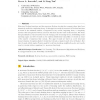Free Online Productivity Tools
i2Speak
i2Symbol
i2OCR
iTex2Img
iWeb2Print
iWeb2Shot
i2Type
iPdf2Split
iPdf2Merge
i2Bopomofo
i2Arabic
i2Style
i2Image
i2PDF
iLatex2Rtf
Sci2ools
APPROX
2015
Springer
2015
Springer
Learning Circuits with few Negations
Monotone Boolean functions, and the monotone Boolean circuits that compute them, have been intensively studied in complexity theory. In this paper we study the structure of Boolean functions in terms of the minimum number of negations in any circuit computing them, a complexity measure that interpolates between monotone functions and the class of all functions. We study this generalization of monotonicity from the vantage point of learning theory, establishing nearly matching upper and lower bounds on the uniform-distribution learnability of circuits in terms of the number of negations they contain. Our upper bounds are based on a new structural characterization of negation-limited circuits that extends a classical result of A. A. Markov. Our lower bounds, which employ Fourier-analytic tools from hardness amplification, give new results even for circuits with no negations (i.e. monotone functions). 1998 ACM Subject Classification I.2.6 Learning, F.2.2 Nonnumerical Algorithms and Pro...
Related Content
| Added | 16 Apr 2016 |
| Updated | 16 Apr 2016 |
| Type | Journal |
| Year | 2015 |
| Where | APPROX |
| Authors | Eric Blais, Clément L. Canonne, Igor Carboni Oliveira, Rocco A. Servedio, Li-Yang Tan |
Comments (0)

